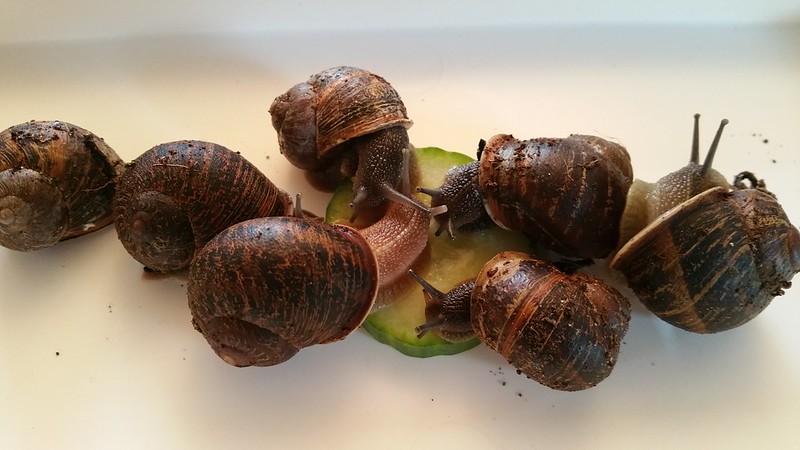
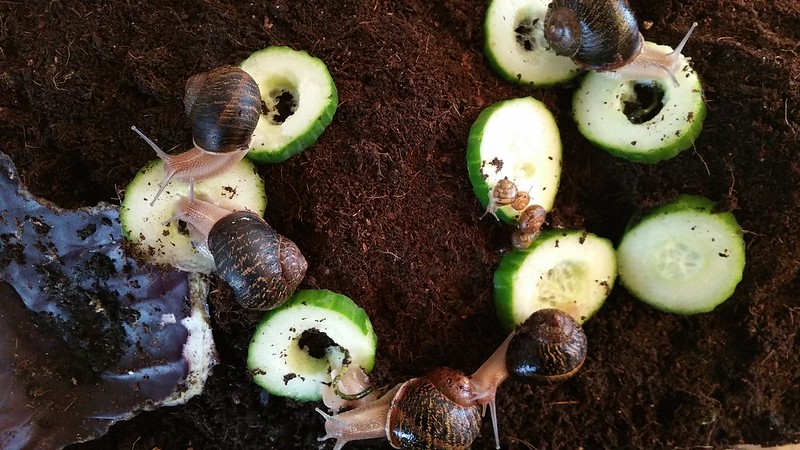
I don't know why I haven't made a more lengthy post about snails until now! Hello world and horrified neighbours, I've been rearing terrestrial mollusks of the English Garden persuasion for over a year now! (I like to call my tank "Snail TV" - its pretty soothing to watch them slide around like bizarre alien marzipan swans). George thinks I'm obsessed about them because they're a bit like rocks with faces on them, and I think there is some truth to that. They are so strange! But reactive and very very curious!
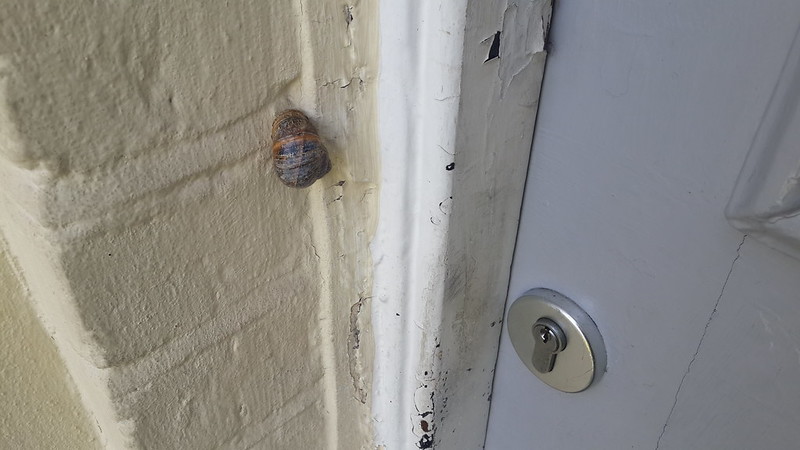
HELLO? DO YOU WANT TO COME IN?
It first began because I found all these snails outside, and then I got very excited about observing their behaviour, and how they ate, but George said I could only have as many "pet snails" as I could identify by name. So we began with five little snails - Robinson Crusoe (a very adventurous but not very hungry snail), Wetherspoons (a very hungry snail), Harvester (an even more hungry snail), Prince of Wales (a yellow grove snail) and Shakespeare (a late comer who appeared to be shunned by the others).
For a period I also almost kept slugs but I discovered that the slugs were aggressively invasive SPANISH SLUGS which I felt bad about returning to the wild after I had discovered what they were. So I put the slugs on our roof. I have to admit I am not sure if this has contributed to the increase in the sound of flapping wings of birds from on top of our roof. But I figured it was a kind of tactical course for the slugs where they have to try to survive on top of our mossy roof. I don't want to kill them but by putting them on the roof, I am lowering their chances of out-eating the local snails and slugs on the ground.
Best part is that snails are like some kind of natural 3D extruder. For example, they love to eat paper and cardboard. I was giving them a habitat made of coloured egg boxes, but they like to eat the boxes and now all their poop (and habitat) is purple, orange, and green.
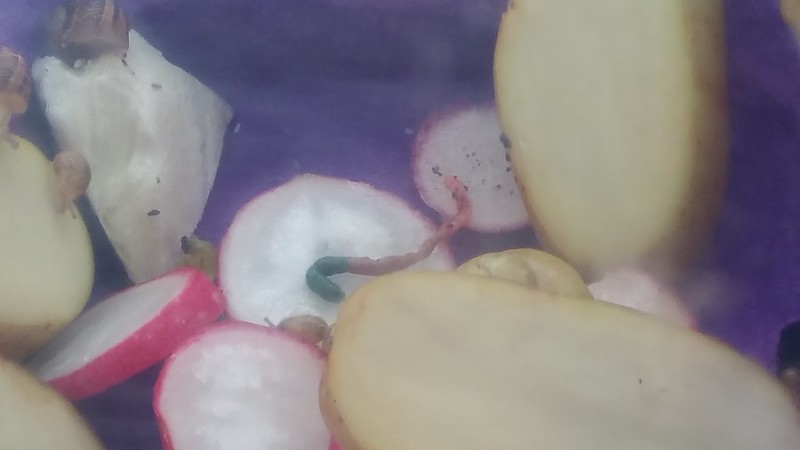
TRI-COLOURED POOP
To be honest I think of them as simple machines, they slide around and they swivel their food detecting feelers around until BEEP! FOOD DETECTED! And the snail deploys its nommmmming action. (Although I HATE the word nom in most cases, it seems appropriate for snails as their mouth does indeed look a lot like "nommmmm" from afar.
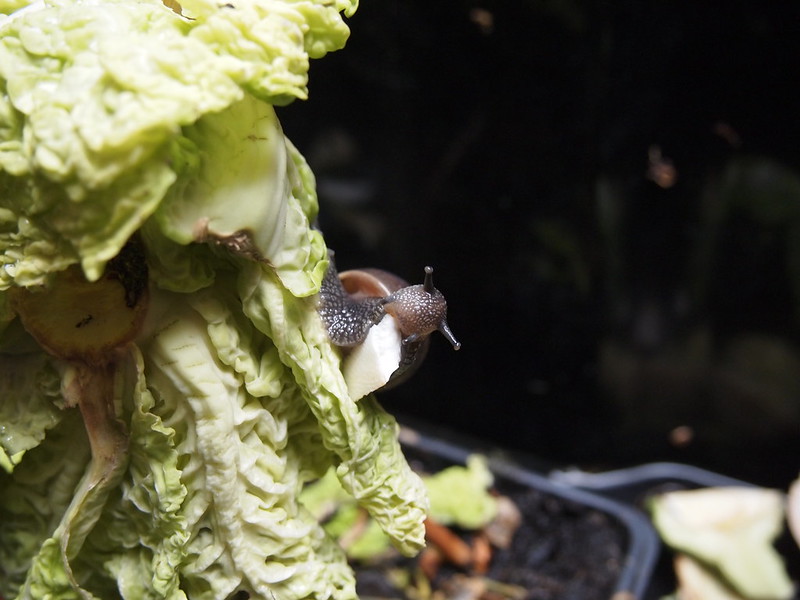
NOMMMMMMMMMM
Now it is about a dozen generations on and we have re-wilded many snails since and kept as many as we think we can comfortably keep.
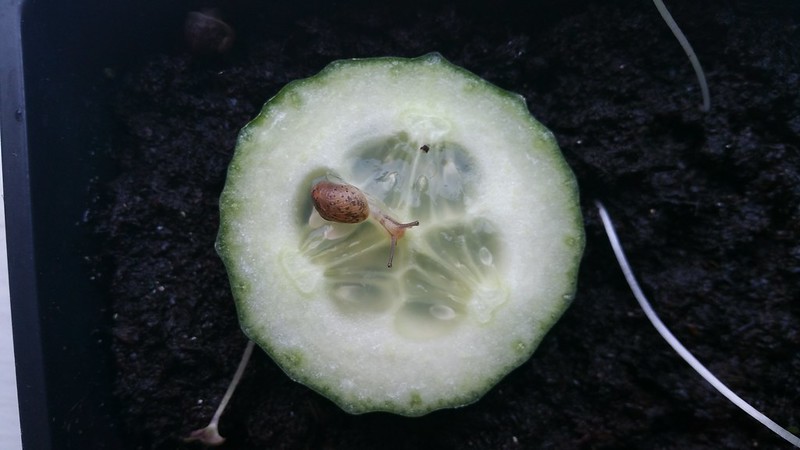
LIFE OF SNAIL
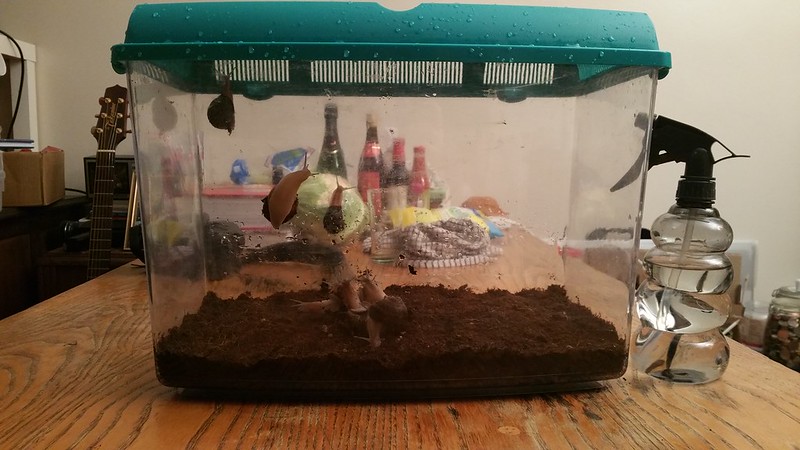
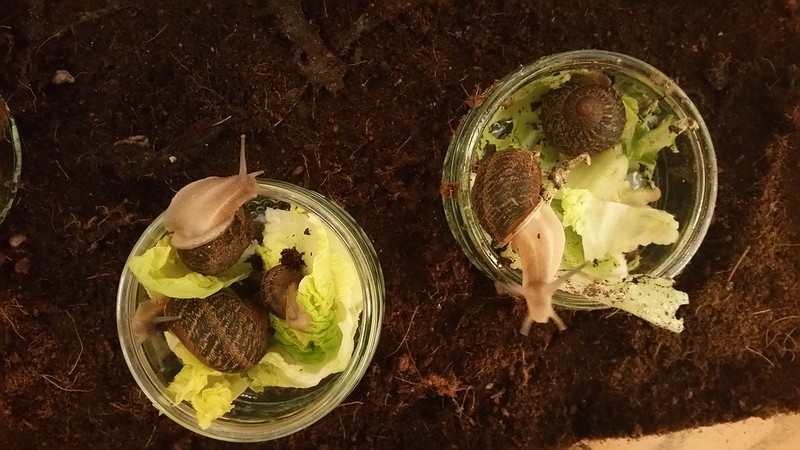
A picture from December 2015, before population explosion
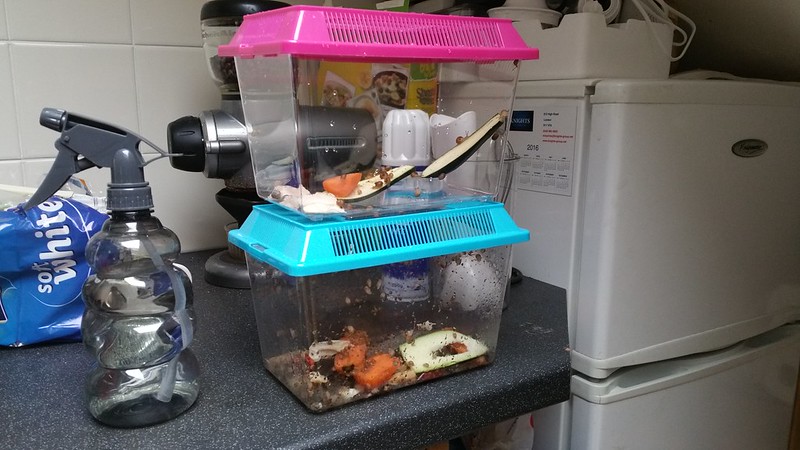
The "Nursery": I isolated batches of babies into smaller tanks at one point, because the babies were occupying the corners where the adults seem to like to sit.
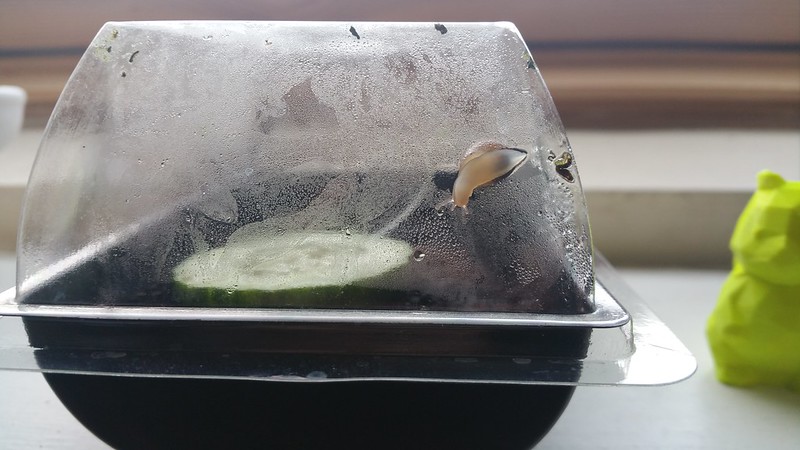
This was a short-lived experiment in which I tried to grow food for snails - to make a closed cycle of feeding and growing. We need something fast growing because they eat very very fast. I used mung bean sprouts for the first experiment. The sprouts became uncontrollable after a few days and then about two weeks later all the stupid sprouts died suddenly! With that, some sort of change in the air caused all the snails to estivate. So they were moved back to boring old "feeding" tanks.
Some notes from my first year of snailkeeping:
- Snails eat most vegetables except for leek/onion/garlic type vegetables. They don't seem to like very acidic fruits like sweet berries and bananas. They may become picky if given too much choice, such as ONLY EATING THE SOFT CENTRES OF CUCUMBERS AND THEN NOT EATING THE REST, or ONLY EATING THE SOFT CENTRE OF A CARROT.
- Snails must be fed cuttlefish bone or some other source of calcium. We went with cuttlefish bone which contrary to what one might imagine, is not harvested from live cuttlefishes. People scavenge for the bones on the seaside and then sell it for money so that pets with shells/beaks can eat these supplements. Oh and what happens in the wild? I suppose the snail will lick your walls then...
- COVER SNAIL TANK WITH ORGANZA FABRIC (OR SOME OTHER BREATHABLE FABRIC) - IF NOT ROTTING VEGETABLES WILL ATTRACT FLIES AND CAUSE HORRIFYING MAGGOTY MOMENTS IN THE SNAIL TANK!
- Snails will climb upwards if it is wet
- Cocopeat is a great and clean snail tank bedding material
- Do not allow snails to crawl on to a laptop which is metallic including macbook pros - a current passes through them when they crawl on metal and the snail will froth up
- Do not allow snails to crawl on exposed metal, foil, copper, they will froth up
- Do not give beautiful fruit and vegetable without washing thoroughly - sometimes pretty fruit has more pesticides, snails won't eat them (it was designed to stop them anyway)
- When garden snails develop a white lip at the end of their shells, they have become adults
- Do not give pasta or rice, they may overfeed and explode.
- If you wiggle a string in front of them, they will crawl up the string
- If you wiggle your finger just in front of their faces, they will crawl up onto your finger, unless they aren't in the mood to slither about.
- When they have detected edible surfaces, their mouthfeelers and seeingfeelers will droop downwards, almost becoming fat and stout at the same time. If their seeingfeelers are fat and droopy, you can bet that they are probably chewing on something at the moment.
- Some snails like eating a lot more than others. Some like digging themselves a hole and hiding all the time.
DEATH OF SNAIL
The lifespan of these garden snails is about 3 years apparently. And snails lay dozens and dozens of eggs in each clutch. And amongst those baby snails, some will die for seemingly no reason at all. It is almost as if some snails just lose the will to live.
A while back, an adult snail passed away whilst I was away. It was the first young adult snail (white lip already grown) to die like this so I had to figure out what to do. I wanted to keep his shell as well, but I needed to clean it somehow. The problem was that it was not easy to remove the body from the shell. George was not keen that I boil the snail in one of our pots. And I don't have a garden, otherwise I could have buried the shell and allowed nature's little workers (ants, etc) to eat and clean out the shell. (In professional forensics/museum situations, a dermestarium with lots of Dermestid beetles (carrion beetles) is used as they are more meticulous than humans and it puts less stress on the bone/shell)
Although I had concerns that freezing the shell might cause it to crack when the water expands inside it, this method I found to have worked perfectly without damaging the shell. This also works for tinier shells.
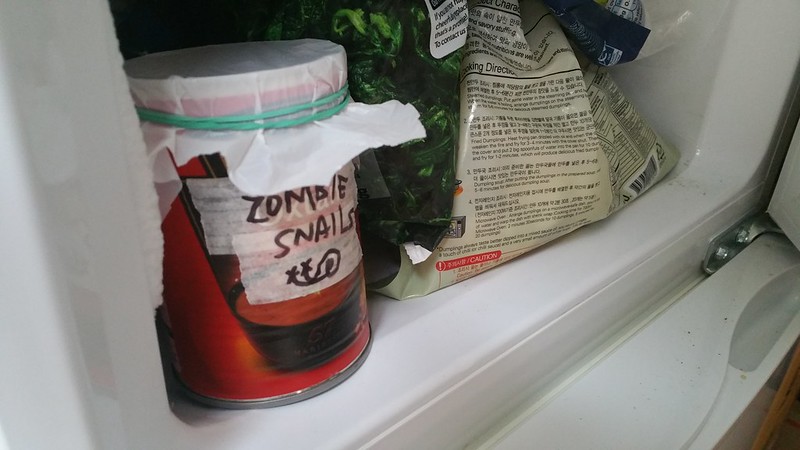
- Place snail in a plastic bag
- Fill plastic bag with some water so the shell is submerged, and place bag into a container
- Place in fridge with label so no one gets a shock when they look into container in the freezer
- Let it freeze overnight
- Thaw it the next day
- Dead snail will have detached from shell so you can clean the shell in water without doing some horrifying digging
- Dry and polish with mineral oil so the shell won't dry out and the layered patterns on the shell won't crack up and peel off.

Very cool. thank you for the blog. My 4 year old granddaughter, Cira and I saved a snail from a most certain death. He was surrounded by nearly 100 fellow snails who were unable to beat the heat. He was the only surviving snail. Thanks to Cira tlc he's doing great. Or is it a she? Can you help with this delima? We are also interested in the reproduction process and baby snail rearing? Also can you share more on common DO'S and Don'ts We should be aware of in order to keep our snail healthy and alive?
ReplyDeleteThanks you again and keep up the good work.
Grandma Karlyn, Cira and the last slimy snail.